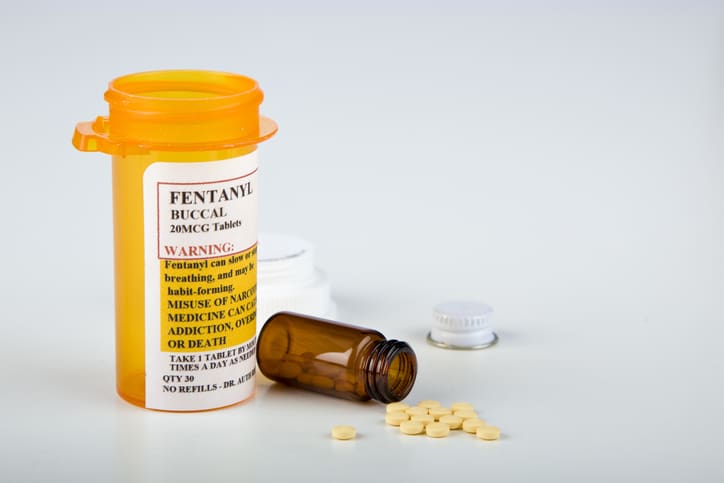A synthetic opioid, fentanyl is 50 times more potent than heroin and 80 to 100 times more potent than morphine. It is a prescription drug used to treat severe pain, especially after surgery or for advanced cancer. However, fentanyl is also made and sold illegally. Fentanyl is a very dangerous drug. Even a tiny amount can be deadly. A public safety notice released by the United States Drug Enforcement Administration (DEA) warns that just two milligrams of the drug, the amount that fits on a pencil tip, is enough to be a potentially fatal dose.
Two Types of Fentanyl
Pharmaceutical Fentanyl
The DEA lists pharmaceutical fentanyl as a Schedule II narcotic. Schedule II drugs are considered dangerous. They have a high potential for abuse, leading to severe psychological and physical dependence. Prescribed by physicians, pharmaceutical fentanyl is used for managing chronic or acute pain. The drug is administered by IV injection, IV drip, dissolving tablets, oral lozenges, injectable liquid, transdermal patches, nasal spray, or film strips.
As the drug crisis in the United States continues to spread, prescribed pharmaceutical fentanyl is increasingly misused and abused. Several examples of misuse include the following:
- The gel from transdermal patches is scraped off, heated, and ingested
- Transdermal patches are cut into pieces and placed inside the cheek or chewed
- Lozenges or tablets are crushed and snorted
- Lozenges or tablets are crushed, mixed with a liquid, and injected
It is crucial to recognize that any method of illicit use of pharmaceutical fentanyl is not only illegal but also incredibly dangerous. The potency of pharmaceutical fentanyl makes it easy to consume a lethal dose accidentally.
Illegally Made Fentanyl
Illegally made fentanyl is a synthetic opioid manufactured in secret laboratories and sold on the black market. It is often mixed with other drugs, such as heroin, cocaine, and methamphetamine, or made into counterfeit pills that resemble prescription opioids. Illegally made fentanyl is extremely dangerous and can be fatal, even in small doses. It is typically made using cheap, easily available ingredients and produced in unregulated conditions. This means that the purity and potency of the drug widely vary, making it impossible for users to know what they are getting.
Illegally made fentanyl is a major contributor to the opioid overdose epidemic in the United States. According to a report from the National Institute on Drug Abuse (NIH), in 2021, nearly 71,000 drug overdose deaths involved synthetic opioids, which include fentanyl. That is almost 22 times the rate of overdose deaths involving synthetic opioids in 2013.
How Does Fentanyl Affect the Brain and Body?
When a person uses fentanyl, the powerful opioid binds to specific receptors in the brain responsible for pain perception and pleasure. The result is a surge of dopamine, a neurotransmitter associated with reward and reinforcement. The dopamine surge creates a feeling of relaxation and a euphoric high. However, fentanyl use can lead to cognitive impairments including confusion, disorientation, and memory loss. Long-term misuse of fentanyl may even result in permanent cognitive damage.
The body’s physical response to fentanyl misuse is just as alarming. Constricted blood vessels, decreased blood pressure, and slowed heart rate occur. The gastrointestinal system slows down causing constipation, nausea, and vomiting. But the most concerning effect of fentanyl misuse is its impact on respiratory function. The drug depresses the central nervous system, slowing breathing to dangerous levels. This can lead to respiratory failure, resulting in brain damage or death.
The Signs of a Fentanyl Overdose
Recognizing the signs of a fentanyl overdose could save a person’s life. The CDC lists the following signs of a possible fentanyl overdose:
- Eye pupils are constricted, small, and pinpoint
- Breathing is weak, slow, or the person is not breathing at all
- Falling asleep, inability to stay awake, losing consciousness
- Gurgling or choking sounds
- Skin is cold, clammy, or both
- Limp body
- Discolored skin – especially nails or lips
If you believe someone may be overdosing on fentanyl or any drug, call 911 as quickly as possible. It is possible to reverse a fentanyl overdose by administering naloxone (Narcan) and quick medical attention. A person who overdoses on fentanyl may need multiple doses of naloxone because of the strength of fentanyl.
We Can Help
Addiction to drugs or alcohol can happen to anyone. If you or a loved one struggles with addiction, help is available. At Anabranch Recovery Center, located in Terre Haute, Indiana, caring professionals can help you take back control of your life. Today is the day to take the first step toward sobriety. Contact Anabranch today.




